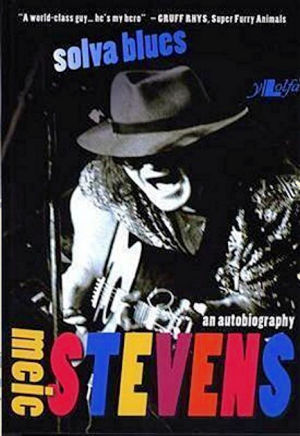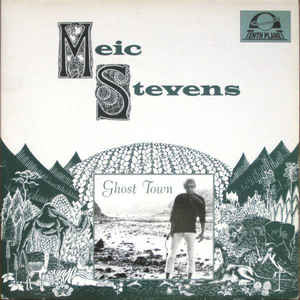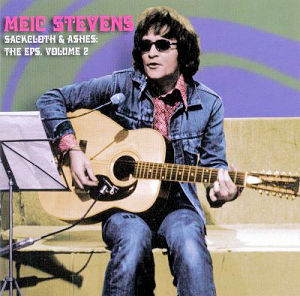http://atagong.com/iggy/archives/2010/06/entry_452.html

The Church is much obliged to Prydwyn who guided us towards Meic Stevens's autobiography and who was so friendly to translate the texts from Welsh to English. This article has mainly been written by him. Meic meets Syd (by Prydwyn) Meic Stevens is as huge and influential a name in the Welsh-language folk, rock, and pop scene as Bob Dylan is (was) in the English-speaking world. Meic has been recording since 1965 (mostly in Welsh, although for those not willing to take him on in the language of Heaven, his outstanding 1970 psychedelic masterpieceOutlander has recently been reissued on CD). For the most part he has performed under his own name, although in the late 60s he was a member of Gary Farr’s backing group in London (playing with Farr at the Isle of Wight Festival in 1969, the festival Syd went to with Margaretta Barclay [note from FA]). Meanwhile in Wales (and in Welsh) he, Heather Jones, and Geraint Jarman performed as ‘Y Bara Menyn’ as well (late 60s). Meic Stevens: “I got a contract in 1965 for a record I’d written myself called Did I Dream. Decca were going to try to market me as another Donovan or Bob Dylan. But it all got too much for me, I had a nervous breakdown and ended up back at Solva.” Meic returned to his home village of Solva, Pembrokeshire, to recover, a time he details in his first autobiography, Solva Blues, and he soon became a feature of the Welsh-language folk and blues scene. In 1969 he was signed by Warner Brothers but after his first album Outlander, the contract was abandoned by mutual consent. (Taken from: Wales Online, interview by Robin Turner.) The following extracts are from Meic Stevens first biography, Hunangofiant y Brawd Houdini (2nd edition 2009, originally from 2003), with translations following. An English version of this autobiography has also been issued, although I haven’t read it and so am not 100% sure it contains the same information. (The Church is currently trying to catch the English version of the book through one of its many believers, note from FA.) The first piece refers to 1969. It must have been spring or summer, as the next section in Stevens's autobiography is about the Isle of Wight Festival. Meic Stevens, his partner and children were living in a farmhouse (called Caerforiog) near Solva in rural southwest Wales. English translation: Rhydderch Jones was a producer/director for the BBC’s Welsh-language service at the time. This excerpt doesn’t make it fully clear if Syd appeared in the London or Wales parts of the shooting, although it is hinted that it was made while Syd visited Meic in Wales (note from FA). Neither do we know if any of Syd's footage survived at all in the five-minute segment that was eventually broadcast. But it does confirm the year (1969) and the place (Caerforiog near Solva) where Syd visited Meic. A message from the Church: We leave it up to other Syd scholars to contact the Welsh branch of the BBC in order to locate the missing reels of the original documentary. Some of the people mentioned above are still around and can be contacted through the BBC or are present on social network websites. And if you do find something, please let us know! The next bit is part of the description of the recording sessions for Meic’s 1970 (mostly) English LP, Outlander. As the album was recorded in 1969 it fixes the date of this anecdote also in that year. English translation: Finally, there is mention of a Syd somewhere in 1964 or 1965, although I don’t think the man in question is Syd Barrett. Still, just in case. English translation: Chalk Farm is an area lying in the London borough of Camden. In 1964 Syd Barrett was living in Mike Leonard's house in Stanhope Gardens, Highgate. The next year he moved to the West End, renting rooms at 12, Tottenham Street. As none of these addresses are next door to Chalk Farm it probably was another Syd Meic Stevens is talking about. Also if Meic had met Syd Barrett (who was still an amateur musician at that point) in 1964 or 1965 he would certainly have stressed this a bit more... (Note from FA.) Sources: (other than internet links mentioned above)2010-06-10
Meic meets Syd
 In a previous post it was told how Margaretta Barclay and Rusty Burnhill took Syd Barrett to acid-folk singer Meic Stevens in Wales, trying to raise Syd's appetite to play some music again. None of the Barrett biographies, including the most recent one from Rob Chapman, have mentioned this, although it was not exactly a secret as Stevens recalls the visits in his autobiography that appeared in 2003.
In a previous post it was told how Margaretta Barclay and Rusty Burnhill took Syd Barrett to acid-folk singer Meic Stevens in Wales, trying to raise Syd's appetite to play some music again. None of the Barrett biographies, including the most recent one from Rob Chapman, have mentioned this, although it was not exactly a secret as Stevens recalls the visits in his autobiography that appeared in 2003. Syd Barrett with Meic Stevens in a lost BBC documentary
Syd Barrett with Meic Stevens in a lost BBC documentaryRo’n i’n dal i wneud peth gwaith i’r BBC yng Nghaerdydd pan gwrddes i â chyfarwyddwr ifanc, Gareth Wyn Jones, oedd am ffilmio rhaglen ddogfen amdana i a ’mywyd. Cymeradwyodd y pennaeth rhaglenni y syniad o gael y cywaith ’ma yn rhan o bump o raglenni dogfen am Gymry cyfoes. Roedd un ohonyn nhw am waith gwneuthurwr drymie o Gasnewydd.Daeth criw ffilmio i lawr am wthnos a ffilmio yng Nghaerforiog, Solfach, a Thyddewi. Wedyn wthnos arall lan yng Nghaerdydd a Llunden. Y cwbwl wnaeth Gareth oedd ffilmio ein bywyd arferol ni o ddydd i ddydd...Ymhlith y rhai eraill a ymddangosodd yn y ffilm roedd Heather a Geraint, Gary Farr a Mighty Baby yn Llunden, a Syd Barrett o Pink Floyd fydde’n dod i’n gweld ni yng Nghaerforiog.Yn nes ymlaen, ffraeodd Gareth ’da’r BBC a mynd i weithio yn Singapore, gan adael y ffilm heb ei golygu. Beth amser wedyn, rhoddodd y BBC ganiatâd i gyfarwyddwr arall olygu portread pum munud ohona i mas o gesys ffilm Gareth, a chafodd beth oedd yn weddill ei daflu mas. Wyth rîl o ffilm un milimedr ar bymtheg oedd yn gyfnod o’n bywyde ni yn 1969! Bachan drwg, Rhydderch Jones!
I was still doing a bit of work for the BBC in Cardiff when I met a young director, Gareth Wyn Jones, who wanted to film a documentary about me and my life. The chief programming approved the idea of getting this joint effort as a part of five documentary programs about contemporary Wales. One of the other ones was about a drum-maker from Casnewydd.The film crew came down for a week and filmed in Caerforiog, Solva, and St. Davids. Then another week in Cardiff and London. All Gareth did was to film our normal day-to-day life…Among the others who appeared in the film were Heather [Jones] and Geraint [Jarman], Gary Farr and Mighty Baby in London, and Syd Barrett from Pink Floyd, who came to see us in Caerforiog.Later on, Gareth quarrelled with the BBC and went to work in Singapore, leaving the film unedited. Some time later, the BBC gave permission to another director to edit a five-minutes portrait of me out of the cases of Gareth’s film, and what was left over got thrown out. Eight reels of 16mm film that were a record of our lives in 1969! Shame on you, Rhydderch Jones!
 Outlander sessions
Outlander sessionsY dyddie hynny, fe fydden ni’n recordio gefen nos fel arfer. Bydde rhai o’r sesiyne’n para tan orie mân y bore – neu drwy’r nos ambell waith – ac wedyn bydden ni’n cael brecwast mewn caffi yn Soho tua saith neu wyth o’r gloch... Allwn i ddim ymdopi ag Olympic, oedd yn hen sgubor fawr o le ’da pentyrre Marshall ar hyd y lle ym mhobman, gwifre spaghetti, a blyche llwch gorlawn.Daeth Syd Barrett lawr yno un noson pan o’n i ar fy mhen fy hun yno ’da gitâr acwstig, ac ro’n i’n falch pan gyrhaeddodd Syd y tresmaswr ’da’i gariad, mynd â’r gitâr, iste ar lawr, a dechre chware iddo fe’i hun. Ro’n i wedi recordio trac y noson honno, o’r enw ‘One Night Wonder’, ac mae e ar Ghost Town, Tenth Planet Records. Ar lawr y bydde Syd wastad yn iste; doedd dim celfi yn ei stafell, dim ond estyll pren moel neu rai wedi’u peintio’n oren neu’n las, ffôn gwyn, a Fender Telecaster.Fi oedd un o’r ychydig oedd yn cael mynd yno; dwi’n credu ’i fod e’n hoffi bod ar ei ben ei hun lawer o’r adeg. Ambell waith, fe fydde’n chware’i Telecaster heb ei chwyddo. Dro arall, syllu trwy’r ffenest neu i’r gwagle fydde fe. Doedd Syd ddim fel ’se fe moyn llawer mewn bywyd, dim ond bod ar ei ben ei hun ’da’i feddylie. Roedd e’n foi golygus iawn, wastad ’da merch hardd ar ei fraich pan oedd e mas neu’n gyrru’i Mini Cooper, yn dene fel styllen, ac yn gwisgo dillad ecsotig few siwtie satin croendynn, cryse sidan ffriliog, sgarffie hirlaes, a bŵts croen neidr!
Those days, we usually recorded in the middle of the night. Some of the sessions would continue until the wee hours of the morning – or right through the night sometimes – and afterwards we’d have breakfast in a café in Soho around seven or eight o’clock… I couldn’t cope with Olympic [Studios], which was an old barn of a place with Marshall stacks everywhere throughout the place, wires like spaghetti, and overflowing ashtrays.Syd Barrett came down there one night when I was on my own with an acoustic guitar, and I was glad when Syd trespassed his way in with his girlfriend, took the guitar, sat on the floor, and started playing to himself. I had been recording a track that night calledOne Night Wonder, which is on Ghost Town, Tenth Planet Records. Syd would always sit on the floor; there was no furniture in his room, just bare wooden planks or ones painted orange or blue, a white phone, and a Fender Telecaster.I was one of the few who got to go there; I believe he liked being on his own most of the time. Sometimes, he would play his Telecaster unamplified. Other times, he would stare through the window or into empty space. Syd didn’t seem to want much in life, just being on his own with his thoughts. He was a very good-looking boy, always with a beautiful girl on his arm when he was out or driving his Mini Cooper. He was as thin as a rail, and wore exotic clothes like skin-tight satin suits, frilly silk shirts, long scarves, and snakeskin boots.
 Probably NOT Syd
Probably NOT SydRo’n i’n iste ar y stâr yn Chalk Farm un noswaith yn trial chware fel Big Bill Broonzy, pan ddaeth Syd, y boi oedd yn byw drws nesaf, mas a sefyll yno’n edrych arna i. Ymhen dipyn, medde fe, “Can you play what you’re thinking?” Wedyn, yn ôl â fe at ei deipiadur a chau’r drws. Do’n i rioed wedi meddwl am chware beth o’n i’n feddwl; ro’n i wastad yn trial copïo cerddoriaeth pobol eraill. Ar chwap fel ’ny, fe wnaeth e i fi feddwl yn wahanol am gerddoriaeth, a dwi’n fwy gofalus byth ers hynny.
I was sitting on the stair in Chalk Farm one evening trying to play like Big Bill Broonzy, when Syd, the boy who lived next door, came out and stood there looking at me. After a while, he said, “Can you play what you’re thinking?” Then, back he went to his typewriter and closed the door. I’d never thought about playing what I was thinking; I was always trying to copy other people’s music. Just like that, he made me think differently about music, and I’ve been more careful ever since then.
Chapman, Rob: A Very Irregular Head, Faber and Faber, London, 2010, p. 81.
Stevens, Meic: Hunangofiant y Brawd Houdini, Y Lolfa, Talybont, 2009, p. 138, p. 190-191, p. 202 .
Many thanks to Prydwyn for his writing and translating skills.
No comments:
Post a Comment